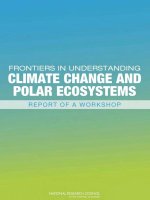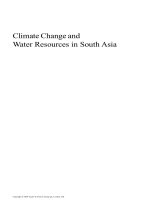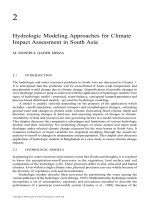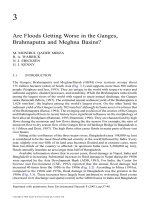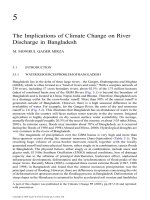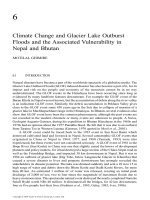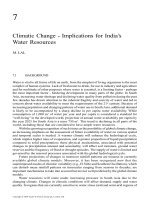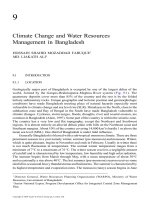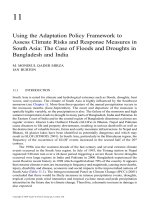Climate Change and Managed Ecosystems - Chapter 18 pdf
Bạn đang xem bản rút gọn của tài liệu. Xem và tải ngay bản đầy đủ của tài liệu tại đây (595.74 KB, 18 trang )
355
18
Knowledge Gaps and
Challenges in Wetlands
under Climate Change
in Canada
B.G. Warner and T. Asada
CONTENTS
18.1 Introduction 355
18.2 Common Misconceptions 356
18.3 Wetland Classification and Inventory 356
18.4 Hydrological Landscape Modifications and Water Budget Fluctuations 360
18.5 Sedimentation and Water Quality Changes 362
18.6 Carbon Cycling and Climate 363
18.7 Invasive Species 363
18.8 Wetland Archival Records 366
18.9 Wetland Ecotechnology: The Way of the Future 367
18.10 Summary and Conclusions 367
References 368
18.1 INTRODUCTION
Wetlands are a characteristic element of the Canadian landscape. They occur any-
where supplies of water on the land surface sustain waterlogged conditions and
anywhere specialized biotic communities are adapted to extreme variations in soil
oxygen between periods of wetness and dryness. The geomorphologic setting of the
land and the buildup of sediments in the wetland itself, especially in the case of peat
landforms, are important factors controlling water conditions in wetlands. Climate
determines the amount of water that enters via precipitation and leaves via evapo-
transpiration and, more indirectly, influences the supply of water that may enter via
surface runoff and groundwater seepage. Human activities can affect the supplies
of water entering wetlands by physically modifying the natural shape and size of
the wetland and its surrounding watershed, by drawing water directly from the
wetland and the sources supplying it, and by altering the vegetation cover, which,
© 2006 by Taylor & Francis Group, LLC
356 Climate Change and Managed Ecosystems
in turn, affects the inputs from and losses to the atmosphere. To understand wetland
and climate relationships is to understand relationships between climate and water,
but these relationships upset the natural balance when human activities interfere and
threaten wetlands and their supplies of water.
Several reviews demonstrate Canada’s considerable progress toward understand-
ing and managing its wetland resources.
1–5
There is a national classification system,
a fundamental first step for defining and recognizing wetlands. Regional inventories
have been performed based on concepts and terms in the classification system. Much
has been learned about differences in the character and dynamics of wetlands through
scientific research and information gathering, which, in turn, wetland managers have
used to develop policies governing wetland protection and wise use. These are not
small accomplishments considering the extent and great diversity of wetlands in
Canada, estimated to be about 18% of the world’s freshwater wetlands.
6
Yet there
is a rudimentary appreciation for the delicate linkages among climate, water, and
wetlands. Wetlands still have not attained the attention they require in assessments
of human impacts on the natural environment. This is exemplified by the number
of threats to drinking water supplies, water pollution problems, major floods,
droughts, fire, and other environmental disasters in recent years in Canada that
revolve around climate, water, wetlands, human health, and economy. Wetlands are,
or should be, considered central to these issues.
This chapter highlights some topical issues, gaps in our understanding of the
role of wetlands in natural and human-dominated landscapes, vulnerability of wet-
lands and the environment when climate compounds the problems, and what we
need to know to better deal with the wetland and water issues in the future. It is by
no means complete but is intended to give a sense of the nature of some problems
and the gaps in knowledge. Wetland ecotechnology presents the opportunity to direct
natural self-organization processes in wetlands to solve problems for the benefit of
both the natural environment and society.
18.2 COMMON MISCONCEPTIONS
Wetland specialists have met at intervals to review progress and prioritize future
directions and information needs. Several workshops have addressed knowledge
gaps and challenges in the science of wetlands for measuring, predicting, mitigating,
and adapting to demands of society including consideration of future changes to
climate.
7–10
The needs and issues with respect to wetlands identified at these national
forums, some more than 10 years ago, still hold to the present. This may, in part,
be due to the needs being so diverse and complex that the wetland community is
challenged to meet all of them and, in part, from a lack of will owing to a number
of common misconceptions about wetlands in Canada (Table 18.1).
18.3 WETLAND CLASSIFICATION AND INVENTORY
Classification is a fundamental prerequisite for all work on wetlands, because it
provides a system for defining and recognizing wetlands in the landscape. Two
© 2006 by Taylor & Francis Group, LLC
Knowledge Gaps and Challenges in Wetlands 357
editions of the Canadian wetland classification have been published, the last of which
is the culmination of nearly 20 years of work.
11
The classification system captures
the range of both peatland and mineral wetland types, including those that are on
land and along freshwater and marine coasts. It also includes those influenced by
permafrost processes.
Classification systems provide the framework for naming and mapping wetlands
in national and regional inventories. It provides the standard “taxonomy” used to
TABLE 18.1
Some Common Misconceptions about Wetlands in Canada
Perception Reality
Wetlands are abundant in Canada and
are not threatened.
Wetlands are most abundant in the Boreal Ecozone. They are
threatened in southern Canada, especially in the most heavily
populated and agricultural areas and elsewhere due to dam
construction and hydroelectric reservoir development.
Wetlands quality is high and they are
not degraded.
True for the most pristine and remote regions, but wetlands
closest to inhabited regions are in various degrees of
deterioration because of incompatible land uses in and
around wetlands, long-term degradation from the historical
past, urbanization, agriculture, discharge of chemical and
biological contaminants, influx of invasive species.
Wetlands are wastelands and
obstacles to development; human
society and wetlands cannot live
together.
Great progress has been made toward effective management
and conservation of wetlands; however, there remains poor
appreciation for the value of wetlands, some perceive
wetlands as frightening and dangerous places, legislation
works against wetlands in some jurisdictions, and there has
been a relaxation by groups and organizations to respect the
benefits and virtues of wetlands.
Restored and created wetlands are
undesirable and unachievable.
Wrong! Many successful restored and created wetlands exist
in Canada, some of which are recognized as internationally
important.
Wetlands are not linked to climate and
are unwanted, because they
contribute greenhouse gases that
warm the climate.
There is a complex linkage between carbon cycling processes
in wetlands and climate. Wetlands not only contribute but
also remove greenhouse gases from the atmosphere in ways
that vary greatly among different wetland types, among
similar wetland types, and within the same wetland basin.
The knowledge base about wetlands
is complete and there is no need for
further work and research on
wetlands.
Wrong! The global scientific community is moving fast to
discover new and important attributes about wetlands that
need to be explored in Canada. For example, we know almost
nothing about aspects of wetland biogeochemistry,
hydrology, microbial ecology, and biodiversity in Canada,
much less the services and values that wetland might
contribute to human society.
The peat moss industry is the only
economic value of wetlands.
Wrong! Canada’s wetland industry as a whole, of which the
peat moss industry is a part, probably contributes as much
to the economic well-being of Canadians as most of the other
natural resource sectors, yet is largely ignored.
© 2006 by Taylor & Francis Group, LLC
358 Climate Change and Managed Ecosystems
name representative wetland types and organize them into groups and subgroups.
Unfortunately, the classification system has not been universally adopted across all
sectors of the federal government even though the Federal Cabinet accepted the
national classification system as the standard to follow when it adopted the Federal
Wetlands Policy in 1992.
12
The 1997 classification system is incomplete and needs refinement. Our concepts
of swamp and bog remain confusing as indicated by some discordance between
definitions of the classification system and the maps produced by Tarnocai et al.,
6,13
largely due to incomplete understanding of the hydrology of wetlands throughout
Boreal Canada. Consideration should be given to explicitly recognizing the condition
or state of the wetland at probably the form or type level in the classification (Table
18.2). This would recognize restored and created wetlands, which are not included.
Degraded wetlands are problematic because they have characteristics that do not
readily fall into the current classification, which is based largely on pristine wetlands.
Further work is required in areas such as the following: the classification needs to
be reevaluated and field-tested for redundancies, generalities, and incompleteness,
and should be brought up to date with current scientific concepts of bog, swamp,
fen, marsh, and shallow open water; restored and created wetlands were largely
overlooked in the 1997 classification and need to be included in the classification
system; in view of the occurrence of corals in Canada’s offshore areas, consideration
of whether the Canadian definition of wetlands needs to be expanded to be brought
in line with the international definition of the Ramsar Convention, which recognizes
coral reefs as components of wetlands; the classification should be used as the basis
for more regional classification systems as recognized by the federal government;
some consideration needs to be given to developing classifications that are based on
both scientific and regulatory needs, such as hydrogeomorphic functional classifi-
cations widely used in the U.S.;
14
and the Canadian classification should be broad-
ened and modified into a classification system for North American wetlands (i.e.,
with the U.S., Mexico), and perhaps toward a global classification for the Northern
Hemisphere.
15
Inventories are only as good as the classification system used as the standard
reference for naming and differentiating the wetland units. The most comprehensive
national inventories are those of Tarnocai et al.
6,13
Most wetland inventories in
Canada exclude large areas of marine, brackish, and freshwater coastal wetlands
(both marsh and shallow open water), and overlook many restored and created
wetlands. The National Wetland Inventory that has been recently launched holds
much promise to improve our knowledge of the extent and distribution of wetlands,
primarily because it utilizes satellite imagery with modern digital imagery processing
techniques.
16
This new initiative must build on the Canadian Wetland Classification
system, and perhaps can help to resolve outstanding problems, such as accurate
differentiation of Picea swamp vs. Picea forest in the Boreal Ecozone, and open
water wetland vs. lake and ocean in coastal zones. Such challenges can only be
confirmed by accurate and supporting field surveys.
Inventory work such as that of Snell
17,18
for southern Ontario needs to be updated
and expanded to other regions of the country, where a significant extent of wetland
has been converted to alternative land uses since European settlement. Such inventories
© 2006 by Taylor & Francis Group, LLC
Knowledge Gaps and Challenges in Wetlands 359
serve to identify priority regions and sites where wetlands are especially vulnerable
and where conservation efforts and protection should take precedence (Figure 18.1).
Regions where wetlands may not be especially widespread anymore but existed in the
TABLE 18.2
Classification Considering State of Wetland Condition
Wetland
Type Wetland Condition
Degree of Human
Intervention
Degree of
Direction by
Humans to
Organize Wetland
Ecosystem
Natural Pristine
Degraded
(a) Minor Degradation: partly
influenced by humans retaining same
wetland form and type as before
human contact
(b) Moderate Degradation: a viable
wetland is retained but some parts and
forms of the wetland have changed
and the wetland is in a state of
transformation from one wetland type
to another
(c) Major Degradation: the wetland
form and type have been severely
influenced by humans and there is a
general trend of species
impoverishment or replacement of
dominant species by others
Restored Passively restored
Returned to some preexisting state by
one-time human action and remaining
in the new state
Actively restored
Returned to some preexisting state by
ongoing human action
Created Human-initiated
Bringing wetland into existence by
intentional or unintentional action
where none existed previously; able
to persist thereafter
Artificial
Bringing wetland into existence by
deliberate action where none existed
previously; without ongoing human
actions it would revert to its original
condition
Small
Great
Greatly
directed
Not directed
on purpose
Slightly
directed
© 2006 by Taylor & Francis Group, LLC
360 Climate Change and Managed Ecosystems
historical past reflect areas of high probability of success and should be targeted for
restoration. The problem is compounded, because regions where wetlands are most
vulnerable due to historical reasons are also regions where climate-warming scenarios
predict extreme warming and drought.
19
18.4 HYDROLOGICAL LANDSCAPE MODIFICATIONS
AND WATER BUDGET FLUCTUATIONS
Our unwise use and poor management of water resources has created problems for
wetlands that, if they continue, will only pose more serious threats to wetlands under
climate change scenarios. Humans have disrupted the magnitude and timing of natural
river flows through land clearance, dam and reservoir construction, diversion and
transfer of water across watersheds, exploitation of groundwater aquifers, channeliza-
tion of streams, and reconfiguration of coastlines in Canada. These activities allow
control of water resources to generate electricity, supply water for agriculture and
industry, mitigate flooding, navigate rivers and lakes, and use the land and near shore
for purposes incompatible with natural conditions.
20,21
Canada ranks third next to the
FIGURE 18.1 Map of Canada showing regions where wetlands are most threatened. (Mod-
ified after Rubec.
76
)
0 500 1000
kilometers
N
High
Moderate
Low to None
© 2006 by Taylor & Francis Group, LLC
Knowledge Gaps and Challenges in Wetlands 361
U.S. and Russia in having the greatest number of major dams.
21
Innumerable wetlands
and aquatic habitats have been lost and altered as a result of these landscape changes.
Land clearance by early settlers changed the land from being forest, wetland,
and water-dominated to one that is open, drier, and largely devoid of wetlands.
Smaller water bodies and streams were obliterated and larger ones became larger,
so large that rivers overflowed and changed their channels and water levels rose
in the receiving water bodies. Land-use history necessitated the creation of the
Conservation Authorities system in the 1940s in Ontario to monitor floods.
22
The
loss of wetlands and water bodies on the Prairies prompted the formation of
Ducks Unlimited Canada in 1938 to reverse the historical trends and restore
wetlands.
22
Large to small dam construction has increased fivefold since the 1950s. This
has resulted in major changes in the volume of water flowing in rivers by water
being impounded in upper reaches and significant decreases in volumes reaching
lower reaches and the river mouth. Extent of dam construction on a single water-
shed can be substantial. For example, the Columbia River Basin in Canada and
the U.S. has 19 dams on its 2000-km length; only 70 km of the river remains free
flowing and natural.
21
What has this kind of control of natural water flow done to
wetlands in the watershed? Another serious problem is the change to natural
seasonal patterns of river discharge. This has led to an increase in the age of waters
reaching the river mouth because it may take water more than a year to reach the
mouth compared to days and weeks under natural conditions. The hydroperiods
of wetlands in riparian zones have changed, the influx and/or efflux of nutrients
have increased, and water and/or nutrients in downstream areas are diminished.
The reservoirs themselves have altered natural habitats. Source and sink strength
for greenhouse gases have been affected by the reservoirs that can emit large
quantities of greenhouse gases.
24
Hydroelectric reservoirs are particularly a prob-
lem because not only are they sources of greenhouse gases, but also of methyl-
mercury, which accumulates and biomagnifies in the aquatic food chain.
25,26
Hydro-
electric development is the primary threat to wetlands in central parts of Manitoba,
Ontario, and Quebec (Figure 18.1).
Wetlands must be a central concern in understanding the impact of hydrological
alterations. The obvious impacts are complete displacement and destruction of wet-
lands, but less known are the less obvious subtle changes to wetland water budgets
and the responses by wetland biota. Detailed information needs include the follow-
ing: undertake detailed evaluation of the state of existing knowledge base and
prioritize information needs on impact to wetlands of hydrological alterations; assess
impacts of seasonal changes to river runoff cycles on water budgets and hydroperiods
of associated wetlands, especially wetlands in riparian and floodplain zones; identify
linkages between large-scale hydrological alterations, regional water cycles, wet-
lands, and climate; determine changes to hydrological conditions, nutrient cycles,
and biota in wetlands in upstream vs. downstream reaches; undertake historical
comparisons between pre-disturbance and present-day landscapes, wetland ecosys-
tems, and climate, which can be readily done using paleoecological techniques, and
long-term monitoring sites need to be established to assess future impacts; and
consider conversion to wetland for reservoirs and impoundments when they are
© 2006 by Taylor & Francis Group, LLC
362 Climate Change and Managed Ecosystems
decommissioned and taken off-line. Gorham et al.
27
have reviewed the merits of the
longer time frames and spatial scales offered by paleoecological approaches in
dealing with environmental problems that directly and indirectly affect peatlands.
There needs to be much greater use and recognition of the archival record in
peatlands as an important management tool for climate change.
18.5 SEDIMENTATION AND WATER QUALITY
CHANGES
Overloading of sediments and nutrients due to poor land-use practices is a major
threat to wetlands. The gaps and needs in this area with respect to wetlands are
complex and have been addressed by the workshops referred to earlier. They are
also closely related to issues surrounding hydrological alterations discussed previ-
ously. This area has received little attention in the context of wetlands, but likely is
a large problem in the vicinity of the mouths of many streams and rivers and along
the associated lake shores and ocean coasts of Canada just as it is in other parts of
the world. It has likely escaped the attention of Canadians because the problems
have not yet reached catastrophic proportions although there may well be accidents
waiting to happen. There have been intermittent reports in the Canadian popular
press in recent years that report fish kills in our water bodies that are usually
attributed to natural cyclic phenomena. There needs to be discussions of nutrients
and overall water quality when such fish kills do occur to ensure that poor land-use
practices are not contributing to “natural phenomena.” Lessons learned from the
Mississippi basin issue can help in Canada.
The Gulf of Mexico hypoxia problem in the U.S. serves as a good example for
Canadians to illustrate the magnitude of problems of poor land-use management
and the catastrophic environmental and economic consequences exacerbated by
warm climate. Nutrient loading and sedimentation throughout the Mississippi River
basin has been shown to increase significantly in recent decades. A zone of low
oxygen levels less than 2 mg l
–1
has been noted on the continental shelf of the
northern part of the Gulf of Mexico.
28–30
Transport of excess nutrients by the Mis-
sissippi River has contributed to increased primary production along with warm
summers and regional water circulation processes has been found to be responsible.
Nitrate concentrations from the Mississippi River show major increases in the 1950s
after nitrogen fertilizer came into widespread use and after expansion in other
activities such as artificial drainage and hydrological alterations in the basin, such
as increased runoff, wastewater discharge from urban settlements, and intensification
of agriculture contributed to the problem.
29
Hypoxia is exacerbated by warm climate.
Restoration of wetlands is viewed as ways by which nutrients and sediments can be
controlled from entering the river and transported downstream to the river mouth.
28
Sedimentation and a decline in water quality in the Great Lakes have been attributed
to agriculture and urbanization in adjacent watersheds and efforts are under way to
restore wetlands to correct the problem.
31
© 2006 by Taylor & Francis Group, LLC
Knowledge Gaps and Challenges in Wetlands 363
18.6 CARBON CYCLING AND CLIMATE
Wetlands contain the largest quantities of carbon in both their living biomass and
in their deep peat and sediments in the terrestrial biosphere. Canada contains around
one third of the global peatland carbon although uncertainties exist on extent of
peatland and carbon in the world.
32
Wetlands in Ontario are estimated to contain
about 19% of Canada’s wetland carbon and about 6.6% of the wetland carbon in
the world.
33
The recent review of McLaughlin
32
presents a good summary of the
current state of knowledge of wetland carbon cycling that, despite a focus on Ontario,
applies to much of Boreal Canada. Large-scale assessments of general climate
change effects on carbon cycling processes are reasonably clear.
33–39
Specific topics
that have received considerable attention include the following: net primary produc-
tion and litter decomposition,
40–42
peat carbon accumulation,
39,43–46
and methane and
carbon dioxide production and emission.
47,48
Different models are being developed
to scale up peatland carbon to landscape, regional, and global scales.
19,49,50
There are several important areas that require further research to refine our
understanding of carbon pools, fluxes, and cycling processes at different temporal
and spatial scales.
32,51
Considerable effort has been directed at quantifying the various
carbon pools but gaps still exist. For example, belowground carbon in litter and roots
is thought to be large in peatlands covered by vascular plants, yet real estimates are
poor at best. There remains incomplete understanding of variability in the nature of
temporal and spatial variability of carbon sink and source strength at microtopo-
graphic scales. Plant community composition differs markedly and climate is
expected to exhibit enough influence to cause vegetation composition to shift both
peatland structure and community type. For example, fens are expected to shift into
bogs and swamps. Such vegetation changes will vary the nature of carbon being
added to the litter and long-term storage. Little is known about how climate will
interact with the new litter quality, oxidation–reduction processes, and microbial
communities. Recent studies show that smaller-scale intrinsic factors such as water
tables, vegetation composition, and litter governed by peatland microtopography and
peat formation may be stronger forces in carbon cycling processes than larger scales
and longer-term responses to changes in climate.
52,53
Climate is expected to enhance
effects of ultraviolet-B (UV-B) radiation on production and decay rates.
54
How will
radiation affect carbon cycling and sequestration processes in peatlands?
Much of the attention on wetland carbon cycling and climate has focused on
peatlands. Mineral wetlands contain significant quantities of carbon, albeit much
less than in peatlands, but in quantities that should not be ignored.
33,55
18.7 INVASIVE SPECIES
Wetlands seem to be particularly favorable habitats for invasive species and warmer
climate may be compounding the problem by allowing more species to survive the
winter period than would otherwise under more severe conditions. Invasive species
are both non-native species and native species that become harmful to the ecosystem
and, in turn, likely cause harm to the economy and humans. The list includes animals
(insects, mollusks, fishes, birds, herpitiles, mammals), plants (algae, bryophytes,
© 2006 by Taylor & Francis Group, LLC
364 Climate Change and Managed Ecosystems
vascular plants), fungi, and microbes. Unfortunately, there is no complete list of
what these species are in Canadian wetlands and aquatic habitats. To compare, a
total of 334 non-native aquatic species have been introduced into wetlands in the
U.S.
56
The Global Invasive Species Database (http:// www.issg.org) lists 18 taxa
(Table 18.3) in Canadian wetlands, but this is only a small fraction of invasive species
actually known to affect fresh, brackish, and marine wetlands. This list does not
include well-known examples such as Dreissena polymorpha (zebra mussel), Tinca
tinca (tench fish), or Cabomba caroliniana (fanwort macrophyte), which are having
major impacts on freshwater wetlands.
57
There are at least 150 non-native invasive
species in the Great Lakes basin that have been introduced in the 1900s.
57
The vast
majority of these live in or close to wetlands. A comparable number of invasive
species are associated with marine and estuarine wetlands of the Strait of Georgia
in southwest British Columbia. Included are such species as Sargassum muticum
(brown seaweed), Zostera japonica (dwarf eelgrass), Venerupis philippinarum
(Manila clam), and Branta canadensis (Canada goose).
57
The status of many alien invasives is poorly understood. A good example is
Phragmites australis, a common wetland plant widely distributed across Canada. It
has become a nuisance in the eastern U.S., and is expanding its dominance throughout
TABLE 18.3
Invasive Species Reported in Wetlands in Canada from the Global Invasive
Species Database (
Scientific Name Common Name Alien or Native Status
Plants
Cirsium arvense Canada thistle (herb) Alien and/or uncertain
Elaeagnus angustifolia Russian olive (tall shrub) Alien
Fallopia japonica Donkey rhubarb (herb) Alien
Hedera helix English ivy (woody vine) Alien
Lespedeza cuneata Chinese bush-clover (herb) Alien
Lythrum salicaria Purple loosestrife (herb) Alien
Myriophyllum spicatum Eurasian water- milfoil (herb) Alien
Phalaris arundinacea Reed canary grass (herb) Uncertain
Phragmites australis Common reed (herb) Alien and/or native
Potamogeton crispus Curly pondweed (herb) Alien
Animals
Cyprinus carpio Carp (fish) Alien and/or uncertain
Gambusia affinis Mosquitofish (fish) Alien
Micropterus salmoides American black bass (fish) Alien, uncertain, and/or native
Mustela erminea Short-tailed ermine (mammal) Uncertain and/or native
Orconectes virilus Northern crayfish (crustacean) Native
Passer domesticus English sparrow (bird) Alien
Rattus norvegicus Norway rat (mammal) Alien
Microbes
Flavivirus spp. West Nile virus Uncertain
© 2006 by Taylor & Francis Group, LLC
Knowledge Gaps and Challenges in Wetlands 365
the Great Lakes Region and parts of eastern Canada. It has been suggested that a more
aggressive genotype of European origin has been introduced to North America and is
displacing native genotypes, giving rise to development of monospecific wetland
communities.
58,59
There is a need to survey P. australis in Canada to differentiate native
and European genotypes to fully understand the impact of invasion by this plant. Is
there a biogeoclimatic difference between the growing conditions of these two races,
and is Canada any more or less vulnerable to widespread invasion than other regions
at more southern latitudes.
Chen caerulescens caerulescens (Lesser snow geese) is another interesting
example where agricultural practices have contributed to changing a native species
into an invasive wetland species threatening many Arctic wetlands.
60
The birds have
changed their overwintering food source from less nutritional sources in natural
marshes on the south coast of the U.S. to agricultural upland sites where food is
more nutritional and accessible. The switch in foraging behavior has contributed to
overpopulations of geese returning to their summer nesting grounds in coastal
marshes in Arctic Canada in numbers the food source in the natural marshes cannot
support.
West Nile virus (WNV; Flavivirus spp.) has been considered a wetland invasive
species because the larvae of mosquitoes inhabit wetland waters and adult mosqui-
toes are the primary vectors for transmission of WVN from their vertebrate hosts
(mostly birds of the Corvidae) to humans. One could debate whether it should be
considered a wetland species. There are several strains of Flavivirus spp., but the
one that has recently appeared in North America and entered Canada in 1999 appears
to have a broad range of hosts and adaptability. A number of blood-feeding arthro-
pods (e.g., sand flies, ticks, and no-see-ums) other than mosquitoes are also thought
to transmit WNV. A total of ten mosquito species have been found in positive WNV
pools in Canada. It is important to determine which mosquito species are more apt
to feed on birds to pick up the virus. Two species, Culex pipiens and C. tarsalis, are
thought to be most active in circulating WNV within the bird populations.
61–63
Culex
pipiens is most common in extreme southern Ontario, Quebec, New Brunswick, and
Nova Scotia, and the southwest part of British Columbia. Culex tarsalis does not
occur in Atlantic Canada, and is confined to extreme southern Ontario, and west-
wards in the southern part of Canada.
64
If true, then should more widespread C.
perturbans and C. territans be of less concern? Recently, it has been suggested that
North American C. pipiens is a hybrid form that readily bites both humans and birds,
compared to its C. pipiens European cousin that tends to bite only birds and not
humans. The recent arrival of this hybrid would account for the recent occurrence
and greater incidence of WNV in humans in North America than in Europe.
65
What
is the C. pipiens in North America and what is the habitat preferences and ecology
of its larvae compared to those in Europe?
There are a number of wetland species that should be monitored closely because
they could become invasive, especially in light of warming winter climates. An
example is Myocastor coypus (nutria), known to exist in Quebec and British Colum-
bia, but it has not reached the nuisance status in Canada it has in the U.S. Eichhornia
crassipes (water hyacinth) has been observed in a coastal marsh on Lake Ontario,
probably introduced from water gardens or aquaria (Warner, personal observations).
© 2006 by Taylor & Francis Group, LLC
366 Climate Change and Managed Ecosystems
Alien invasives pose a major threat to the biodiversity of Canadian wetlands,
some of which are the most diverse ecosystems in the country. Complete biodiversity
assessments for wetlands do not exist. Certain groups of organisms are better known
for certain kinds of wetlands than others.
Important areas for further work on invasive wetland species are as follows:
compile a list of all invasive species in wetlands in Canada, differentiate non-
native and native species, and rank those with the greatest threat to wetlands; set
up monitoring networks to gauge current and future distributions, ecological
interactions, and environmental impacts, and undertake more research to under-
stand the biology and ecology of the invasive organisms; be proactive by setting
up monitoring networks to assess the potential threat of alien species or native
species that may become invasive in the future, especially with the expectation
that there may be major range shifts under future climates; conduct economic
impact evaluations because invasive species cause major economic harm and pose
threats to Canada’s wetland industry; and establish a national network of key
wetlands for biodiversity assessments.
18.8 WETLAND ARCHIVAL RECORDS
Wetlands, especially peatlands, are unusual in that they contain a record of them-
selves preserved in the organic sediments and peat below the surface.
66,67
The peat
archives record continuous environmental changes, including climate, that may go
back thousands of years, in Canada usually the past 15,000 years or so. These long
archival records reconstructed using paleoecological techniques provide a means of
extending back farther in time contemporary weather records and other databases
and records of environmental conditions. The value of comparing and combining
peatland ecosystems on short-time and fine spatial scales of ecologists with the much
longer-time and broader spatial scales of paleoecologists have been discussed by
Gorham
51
and Gorham et al.
27
Some of these are (1) more observations can be made
over greater time and spatial scales, (2) ecosystem processes and responses to
environmental changes such as climate, can be clarified that might be difficult to
see over shorter timescales, (3) species behavior and community structure can be
compared before and after historical period of human disturbances, and (4) human
impacts can be assessed and predicted because of the greater time and spatial scales.
The archival record in peatlands has contributed significantly to improving our
understanding of belowground carbon storage and cycling processes in peatlands as
discussed above. Ecosystem dynamics and succession can be clarified using paleo-
ecological techniques. In heavily populated southern Ontario, several peatland types
are known to have changed in direct response to human interferences within the
historical period and do not represent ecosystems today that have followed “natural”
predictable developmental pathways.
68,69
In other cases, early Holocene climate
warming and the “Little Ice Age” seem to have affected developmental histories.
69,70
Therefore, if past climate influenced past development trends, how might the present
or future climate be affecting these wetlands? Canada contains abundant peatlands
and as such offers the potential for reconstructing widespread longer-term climatic
© 2006 by Taylor & Francis Group, LLC
Knowledge Gaps and Challenges in Wetlands 367
and environmental changes for most parts of the country. Compared to lakes, wet-
lands have not received the attention they deserve.
18.9 WETLAND ECOTECHNOLOGY:
THE WAY OF THE FUTURE
Wetland ecotechnology, also referred to as wetland ecological engineering, is defined
as working with nature for the benefit of both the natural environment and human
society.
71
Wetland ecotechnology is not new to Canada.
72,73
Wetlands have been
restored and created to replace wildlife habitat that has been lost ever since Ducks
Unlimited Canada began its work in 1938. The first wetlands to treat wastewater
and improve water quality were constructed in the late 1970s. Wetlands stabilize
soil erosion and shorelines and they have been used to rehabilitate abandoned gravel
pits and quarries, mine tailings, contaminated soils, and dumpsites. Naturalistic fish
ways that simulate natural channels provide migration passages for fish around dams
and in areas where natural channels are unnavigable by fish. Rainwater can be
recycled through wetlands in urban area and on rooftops, or in wetland-like holding
ponds as storm water. There are thousands of examples in Canada.
Wetland ecotechnology has much potential in Canada so that some of the
problems presented here can be avoided or reduced in the future. Further work is
needed in the following areas: there is little detailed information to verify how and
why various wetland designs work, especially in Canadian climatic conditions;
designs are customized to suite specific needs, which need testing and parameterizing
into standardized designs; and data are needed to assist regulators and managers
with decisions on these nontraditional wetland technologies.
18.10 SUMMARY AND CONCLUSIONS
Wetlands are sensitive to climate changes, especially since they lie between terrestrial
ecosystems and open water bodies. A small change in the quantity of water in the
system can cause the wetland to become more terrestrial or more aquatic. Humans
are responsible for directly altering wetlands by physically changing their shape and
size, readjusting the quantity of water reaching them, and altering the biogeochemical
transformations in wetlands. Invasive species are a major threat to the biological
integrity of wetlands. The stress on wetlands by all of these factors is compounded
by climate. Existing wetlands must be protected from further loss and degradation,
and wetland ecotechnology can be used to replace lost and enhance existing wet-
lands. Wetlands affect climate and climate affects wetlands. Do we need to be
reminded of the “Dirty 30s” in the southern Prairies when drought conditions dried
up all surface water bodies and wetlands? Would this period have been as “dirty”
and as dry if decades before extensive surface water bodies, wetlands, and natural
vegetation had not been converted into cultivated land?
We should be reminded that wetlands support a large industry in Canada.
74
It
has been estimated that over CA$10 billion is derived from wetlands each year.
75
This value is probably a gross underestimate, because the wetland economy includes
© 2006 by Taylor & Francis Group, LLC
368 Climate Change and Managed Ecosystems
four sectors — products and manufacturing, supplies and distribution, services, and
a knowledge sector — that all depend on wetlands and contribute to the Canadian
economy. Claudi et al.
57
have suggested the cost of control for nine alien species
was about CA$5.5 billion and about CA$456 million annually. What impact do
wetland alien invasives, for example, have on the wetlands industry? What is the
economic loss when wetlands are destroyed or altered by poor water management
and pollution by contaminants? What role will climate play in exacerbating economic
costs? Canada’s wetland industry is especially vulnerable because it is diffuse and
includes many small, family-run operations in rural and economically disadvantaged
parts of the country.
Wetlands are commonly confused with terrestrial and aquatic ecosystems in the
landscape. Human activities can dramatically alter the supplies of water entering
wetlands. So too can climate affect water exchanges between wetlands and the
atmosphere. Wetlands are especially vulnerable when humans alter water supplies
on the land and atmospheric inputs by interfering with climate. Too little water may
push wetlands into becoming more terrestrial in character and too much water may
push wetlands into becoming more aquatic. The association and linkage of wetlands
with a number of important environmental issues has probably not been realized
due to several misconceptions. Much remains to be done to refine wetland classifi-
cation schemes. Inventories of Canada’s wetland resource are incomplete and need
to be accurately evaluated to ensure protection of all wetland resources for future
generations. Hydrological modifications of the landscape continue to threaten wet-
lands and regional water budgets. There is a history of converting wetlands into
alternative non-wetland uses, which reduces quantities of water retained on the land
and in the vegetation. Wetlands and downstream receiving water bodies continue to
be severely affected by sedimentation and nutrient loading. Canadians can learn
about the severity and magnitude of the problem from the Mississippi River basin
in the U.S. Invasive species continue to pose new surprises and ongoing threats to
the biological integrity and biodiversity of wetlands. Human activities are responsible
for all of these issues threatening wetlands, which are further exacerbated by climate
changes. Unfortunately, Canadians are ill prepared to recognize and deal with the
threats to wetlands. Canada is well positioned to utilize more widely wetland eco-
technology and nature-sensitive practices to correct historical wrongs and to work
in harmony with nature for the benefit of both wetlands and society so that climate
will not pose as big a threat as might be possible in the future.
REFERENCES
1. Zoltai, S.C. and Pollett, F.C., Wetlands in Canada: their classification, distribution
and use, in Ecosystem of the World 4B, Mires: Swamp, Bog, Fen and Moor, Regional
Studies, Gore, A.J.P., Ed., Elsevier, Amsterdam, 1983, 245–268.
2. National Wetland Working Group, Wetlands of Canada, Polyscience Publishers, Mon-
treal, 1988.
3. Glooschenko, W.A., Tarnocai, C., Zoltai, S., and Glooschenko, V., Wetlands of Canada
and Greenland, in Wetlands of the World 1, Whigham, D.F., Dykyjová, D., and Hejny,
S., Eds., Kluwer Academic, Dordrecht, 1993, 415–514.
© 2006 by Taylor & Francis Group, LLC
Knowledge Gaps and Challenges in Wetlands 369
4. Zoltai, S.C. and Vitt, D.H., Canadian wetlands: environmental gradients and classi-
fication, Vegetatio, 118, 131, 1995.
5. Rubec, C.D.A., The status of peatland resources in Canada, in Global Peat Resources,
Lappalainen, E., Ed., International Peat Society, Helsinki, 1996, 243–252.
6. Tarnocai, C., Kettles, I.M., and Lacelle, B., Wetlands of Canada, Agriculture and
Agri-Food Canada, Research Branch, Ottawa, 2001.
7. Wedeles, C.H.R., Meisner, J.D., and Rose, M.J., Wetland Science Research Needs in
Canada, Wetlands Research Centre, University of Waterloo, 1992, 30 pp.
8. Cox, K., Wetlands: A celebration of life, Sustaining Wetlands Issue Paper 1993–1,
North American Wetlands Conservation Council (Canada), Ottawa, 1993.
9. Clair, T.A., Warner, B.G., Robarts, R., Murkin, H., Lilley, J., Mortsch, L., and Rubec,
C., Canadian inland wetlands and climate change, in The Canada Country Study:
Climate Impacts and Adaptation, Vol. 7, Environment Canada, Ottawa, 1998,
190–218.
10. Rubec, C.D.A., Ed., Wetland Stewardship in Canada, North American Wetlands
Conservation Council (Canada), Report 03-3, 2003, 145 pp.
11. Warner, B.G. and Rubec, C.D.A., Eds., The Canadian Wetland Classification System,
2nd ed., University of Waterloo, Waterloo, 1997.
12. Government of Canada, The federal policy on wetland conservation, Ottawa, 1991,
14 pp.
13. Tarnocai, C., Kettles, I.M., and Lacelle, B., Peatlands of Canada, Geological Survey
of Canada, Open File 3834, Ottawa, 2000.
14. Smith, R.D., Ammann, A., Bartoldus, C., and Brinson, M., Wetlands Research Pro-
gram Technical Report WRP-DE-9, U.S. Army Corps of Engineers, Washington,
D.C., 1995.
15. Scott, D.A. and Jones, T.A., Classification and inventory of wetlands: a global over-
view, Vegetatio, 118, 3, 1995.
16. Leahy, S., Wetlands from space: the national wetland inventory, Conservator, 24, 13,
2003.
17. Snell, E.A., Wetland distribution and conversion in southern Ontario, Working Paper
48, Inland Waters and Land Directorate, Environment Canada, Ottawa, 1987.
18. Snell, E.A., Recent wetland loss trends in southern Ontario, in Wetlands: Inertia or
Momentum? Bardecki, M.J. and Patterson, N., Eds., Federation of Ontario Naturalists,
Don Mills, 1989, 183–197.
19. Kettles, I.M. and Tarnocai, C., Development of a model for estimating the sensitivity
of Canadian peatlands to climate warming, Geog. Phys. Quat., 53, 323, 1999.
20. Schindler, D.W., Sustaining aquatic ecosystems in Boreal regions, Conserv. Ecol., 2,
1, 1998.
21. Rosenberg, D.M., McCully, P., and Pringle, C.M., Global-scale environmental effects
of hydrological alterations: Introduction, BioScience, 50, 746, 2000.
22. Richardson, A.H., Conservation by the People: The History of the Conservation
Movement in Ontario to 1970, Conservation Authorities Branch, Toronto, 1974.
23. Leitsch, W.G., Ducks and Men, Ducks Unlimited Canada, Winnipeg, 1978.
24. Vorosmarty, C.J. and Sahagian, D., Anthropogenic disturbance of the terrestrial water
cycle, BioScience, 50, 753, 2000.
25. Rosenberg, D.M., Berkes, F., Bodaly, R.A., Hecky, R.E., Kelly, C.A., and Rudd,
J.W.M., Large-scale impacts of hydroelectric development, Environ. Rev., 5, 27, 1997.
26. St. Louis, V.L., Kelly, C.A., Ducheman, E., Rudd, J.W.M., and Rosenberg, D.M.,
Reservoir surface as sources of greenhouse gases to the atmosphere: a global estimate,
BioScience, 50, 766, 2000.
© 2006 by Taylor & Francis Group, LLC
370 Climate Change and Managed Ecosystems
27. Gorham, E., Brush, G.S., Graumlich, L.J., Rosenzweig, M.L., and Johnson, A.H.,
The value of paleoecology as an aid to monitoring ecosystems and landscapes, chiefly
with reference to North America, Environ. Rev., 9, 99, 2001.
28. Mitsch, W.J., Day, J.W., Gilliam, J.W., Groffman, P.M., Hey, D.L., Randall, G.W.,
and Wang, N., Reducing nitrogen loading to the Gulf of Mexico from the Mississippi
River basin: strategies to counter a persistent ecological problem, BioScience, 51,
373, 2001.
29. Rabalais, N.N., Turner, R.E., and Wiseman, W.J., Gulf of Mexico hypoxia, a.k.a.
“The Dead Zone,” Annu. Rev. Ecol. Syst., 33, 235, 2002.
30. Turner, R.E. and Rabalais, N.N., Linking landscape and water quality in the Missis-
sippi River basin for 200 years, BioScience, 53, 563, 2003.
31. Environment Canada, Where Land Meets Water: Understanding Wetlands of the Great
Lakes, Environment Canada, Toronto, 2002, 72 pp.
32. MacLaughlin, J., Carbon assessment in boreal wetlands of Ontario, Forest Research
Information Paper 158, Ontario Ministry of Natural Resources, Sault Ste. Marie,
2004, 79 pp.
33. Warner, B.G., Davies, J.C., Jano, A., Aravena, R., and Dowsett, E., Carbon storage
in Ontario’s wetlands, in Climate Change Research Information Note 1, Ministry of
Natural Resources, Sault Ste. Marie, Ontario, 2003, 4 pp.
34. Gorham, E., Northern peatlands: role in the carbon cycle and probable responses to
global warming, Ecol. Appl., 1, 182, 1991.
35. Gorham, E., The biogeochemistry of northern peatlands and its possible responses
to global warming, in Biotic Feedbacks in the Global Climatic System: Will the
Warming Speed the Warming? Woodwell, G.M. and MacKenzie, F.T., Eds., Oxford
University Press, Oxford, 1995, 169–186.
36. Dean, W.E. and Gorham, E., Magnitude and significance of carbon burial in lakes,
reservoirs, and peatlands, Geology, 26, 535, 1998.
37. Tarnocai, C., The amount of organic carbon in various soil orders and ecological
provinces in Canada, in Soil Processes and the Carbon Cycle, Lal, R., Kimble, J.M.,
Follett, R.F., and Stewart, B.A., Eds., CRC Press, Boca Raton, FL, 1998, 81–92.
38. Tarnocai, C., The effect of climate warming on the carbon balance of cryosols in
Canada, Permafrost Periglacial Proc., 10, 251, 1999.
39. Vitt, D.H., Halsey, L.A., Bauer, I.E., and Campbell, C., Spatial and temporal trends
in carbon storage of peatlands of continental western Canada, Can. J. Earth Sci., 37,
683, 2000.
40. Vitt, D.H., Growth and production dynamics of boreal mosses over climatic, chemical
and topographic gradients, Bot. J. Linnean Soc., 104, 35, 1990.
41. Camill, P., Lynch, J.A., Clark, J.S., Adams, J.B., and Jordan, B., Changes in the
biomass, aboveground net primary production, and peat accumulation following
permafrost thaw in boreal peatlands of Manitoba, Canada, Ecosystems, 4, 461, 2001.
42. Asada, T. and Warner, B.G., Surface peat mass and carbon balance in a hypermaritime
peatland, Soil Sci. Soc. Am. J., 69, 549, 2005.
43. Warner, B.G., Clymo, R.S., and Tolonen, K., Implications of peat accumulation at
Point Escuminac, New Brunswick, Quat. Res., 39, 245, 1993.
44. Charman, D.J., Aravena, R., and Warner, B.G., Carbon dynamics in a forested peat-
land in northeastern Ontario, Canada, J. Ecol., 82, 55, 1994.
45. Vardy, S.R, Warner, B.G., Turunen, J., and Aravena, R., Carbon accumulation in
permafrost peatlands in the Northwest Territories, Canada, Holocene, 10, 273, 2000.
© 2006 by Taylor & Francis Group, LLC
Knowledge Gaps and Challenges in Wetlands 371
46. Yu, Z., Vitt, D.H., Campbell, I.D., and Apps, M.J., Understanding Holocene peat
accumulation pattern of continental fens in western Canada, Can. J. Bot., 81, 267,
2003.
47. Bubier, J.L, Moore, T.R., and Roulet, N.T., Methane emissions from wetlands in the
midboreal region of northern Ontario, Canada, Ecology, 74, 2240, 1993.
48. Bellisario, J.L., Bubier, J., Chanton, J., and Moore, T.R., Controls on the emission
of methane from a northern peatlands, Global Biogeochem. Cycles, 13, 81, 1999.
49. Hilbert, D.W., Roulet, N., and Moore, T., Modelling and analysis of peatlands as
dynamical systems, J. Ecol., 88, 230, 2000.
50. Frolking, S., Roulet, N.T., Moore, T.R., Richard, P.J.H., Lavoie, M., and Muller, S.D.,
Modeling northern peatland decomposition and peat accumulation, Ecosystems, 4,
479, 2001.
51. Gorham, E., The future of research in Canadian peatlands: a brief survey with
particular reference to global change, Wetlands, 14, 206, 1994.
52. Belyea, L.R. and Clymo, R.S., Feedback control on the rate of peat formation, Proc.
R. Soc. London, 268B, 1315, 2001.
53. Belyea, L.R. and Malmer, N., Carbon sequestration in peatland: patterns and mech-
anisms of response to climate change, Global Change Biol., 10, 1043, 2004.
54. Gehrke, C., Effects of enhanced UV-B radiation on production-related properties of
a Sphagnum fuscum dominated subarctic bog, Funct. Ecol., 12, 940, 1998.
55. Eulis, N.H., Gleason, R.A., Olness, A., McDougal, R.L., Murkin, H.R., Robarts, R.D.,
Bourbonnierre, R.A., and Warner, B.G., Prairie wetlands of North America important
for carbon storage, Global Biogeochem. Cycles, in press, 2005.
56. Benson, A.J., Documenting over a century of aquatic introductions in the United
States, in Nonindigenous Freshwater Organisms, Claudi, R. and Leach, J.H., Eds.,
CRC Press, Boca Raton, FL, 1999, 1–31.
57. Claudi, R., Nantel, P., and Muckle-Jeffs, E., Alien Invaders in Canada’s Waters,
Wetlands, and Forests, Natural Resources Canada, Ottawa, 2002.
58. Chambers, R.M., Meyerson, L.A., and Saltonstall, K., Expansion of Phragmites
australis into tidal wetlands of North America, Aquat. Bot., 64, 261, 1999.
59. Saltonstall, K., Cryptic invasion by a non-native genotype of the common reed,
Phragmites australis, into North America, Proc. Natl. Acad. Sci. U.S.A., 99, 2445,
2002.
60. Jeffries, R.L., Rockwell, R.F., and Abraham, K.F., The embarrassment of riches:
agricultural food subsidies, high goose numbers, and loss of Arctic wetlands — a
continuing saga, Environ. Rev., 11, 193, 2003.
61. Sibbald, B., Saskatchewan’s West Nile virus surge baffles experts, Can. Med. Assoc.
J. Available online at September 10, 2003.
62. Artsob, H., West Nile: biology of an emerging Flavivirus, in Proc. West Nile Virus
Regulatory Consultative Workshop, Health Canada, Ottawa, 2004, 1.
63. Centers for Disease Control, West Nile Virus. Division of Vector Borne Diseases,
Centers for Disease Control and Prevention, Atlanta, GA, 2004.
64. Darsie, R.F. and Ward, R.A., Identification and Geographical Distribution of the
Mosquitoes of North America, North of Mexico, American Mosquito Control Asso-
ciation, Fresno, CA, 1981.
65. Fonseca, D.M., Keyghobadi, N., Malcolm, C.A., Mehmet, C., Schaffner, F., Mogi,
M., Fleischer, R.C., and Wilkerson, R.C., Emerging vectors in the Culex pipiens
complex, Science, 303, 1535, 2004.
© 2006 by Taylor & Francis Group, LLC
372 Climate Change and Managed Ecosystems
66. Warner, B.G. and Bunting, M.J., Indicators of rapid environmental change in northern
peatlands, in Geoindicators: Assessing Rapid Environmental Changes in Earth Sys-
tems, Berger, A.R. and Iams, W.J., Eds., A.A. Balkema, Rotterdam, 1996, 235–246.
67. Chambers, F.M. and Charman, D.J., Holocene environmental change: Contributions
from the peatland archive, Holocene, 14, 1, 2004.
68. Warner, B.G., Kubiw, H.J., and Hanf, K.I., An anthropogenic cause for quaking mire
formation in southwestern Ontario, Nature, 340, 380, 1989.
69. Bunting, M.J. and Warner, B.G., Hydroseral development in southern Ontario: Pat-
terns and controls, J. Biogeogr., 25, 3, 1998.
70. Bunting, M.J., Morgan, C.R.M., Warner, B.G., and Van Bakel, M., Pre-European
settlement conditions and disturbance of a coniferous swamp in southern Ontario,
Can. J. Bot., 76, 1770, 1998.
71. Mitsch, W.J. and Jorgensen, S.E., Ecological Engineering and Ecosystem Restoration,
John Wiley & Sons, Toronto, 2003.
72. Warner, B.G. and Li, J., Ecological engineering and wetlands. Can. Civil Eng., 15,
16, 1998.
73. Kells, J.A. and Warner, B.G., Emergence of ecological engineering and green tech-
nology, Can. Civil Eng., 17, 11, 2000.
74. Warner, B.G., Canada’s wetland industry, in Wetlands Stewardship in Canada: Setting
a Course Together, Rubec, C.D.A., Ed., North American Wetlands Conservation
Council, Report 03-02, 2003, 81–92.
75. Rubec, C.D.A., Lynch-Stewart, P., Wickware, G.M., and Kessel-Taylor, I., Wetland
utilization in Canada, in Wetlands of Canada, National Wetland Working Group,
Polyscience Publishers, Montreal, 1988, 381–412.
76. Rubec, C.D.A., Policy for conservation of the functions and values of forested
wetlands, in Northern Forested Wetlands: Ecology and Management, Trettin, C.C.,
Jurgensen, M.F., Grigal, D.F., Gale, M.R., and Jeglum, J.K., Eds., CRC Press, Boca
Raton, FL, 1997, 45–59.
© 2006 by Taylor & Francis Group, LLC
